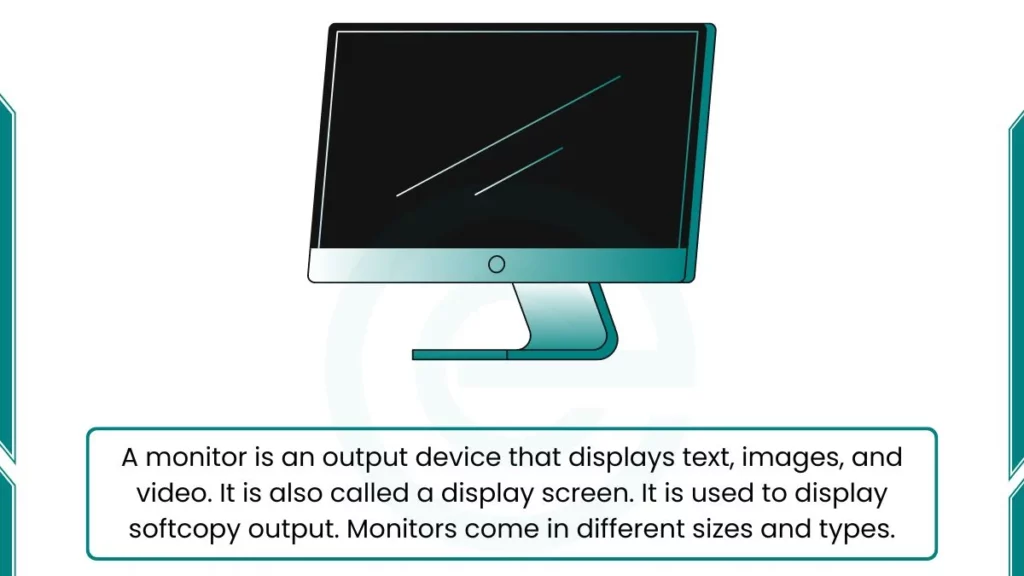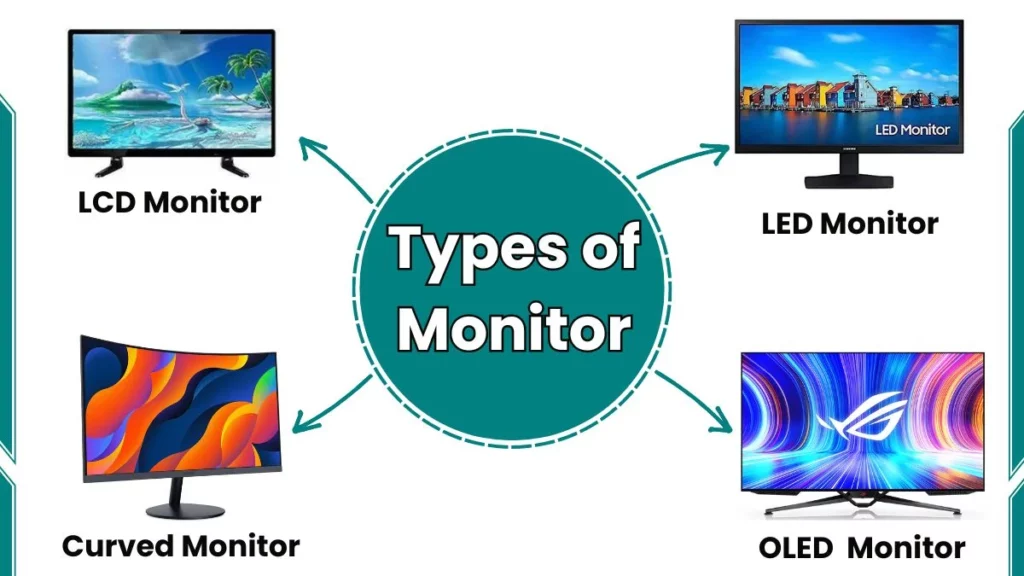Monitors are an essential part of every computer system. They allow users to see and interact with what the computer is doing. Whether it’s text, images, or videos, everything is shown on the monitor. Without a monitor, using a computer would be almost impossible.
Monitor Definition
A monitor is an output device that displays text, images, and video. It is also called a display screen. It is used to display softcopy output. Monitors come in different sizes and types. When you type, click, or play a video, the monitor displays it so you can interact with your computer.

Types of Computer Monitors
There are several types of monitors and each has its benefits. Here are some common types:
- LCD (Liquid Crystal Display) Monitors: These use liquid crystals to display images. They are energy-efficient and have a slim design. LCD monitors are good for everyday use.
- LED (Light Emitting Diode) Monitors: These are a type of LCD monitor but use LEDs for backlighting. They are thinner and lighter than standard LCDs. They also produce brighter colors and deeper blacks.
- Curved Monitors: These monitors have a curved screen that offers a more immersive experience by wrapping the display around the user’s field of vision. Curved monitors are popular among gamers and professionals who work with wide-screen content.
- OLED (Organic Light Emitting Diode) Monitors: These monitors use organic compounds to emit light, offering better color contrast and true blacks. OLED monitors are often more expensive but provide the best visual experience for watching videos and playing games.

Features of Modern Monitors
Modern monitors come with many features that make them better than older models. Here are some important components and features:
- Display Panel: The display panel is the core of the monitor. The most common types of panels are:
- TN (Twisted Nematic): Known for fast response times, making it ideal for gaming.
- IPS (In-Plane Switching): Offers better color accuracy and wider viewing angles. It is great for graphic design and professional use.
- VA (Vertical Alignment): Offers better contrast ratios. Providing deeper blacks and vibrant colors. Suitable for watching movies or video content.
- Backlight: Most modern monitors use LED backlights. They are energy-efficient and help the screen show vibrant colors.
- Adjustable Stand: Many monitors have stands that allow you to change the height and angle. This helps reduce strain on your neck and eyes, making it more comfortable to use for long periods.
- Connectivity Options: Monitors often come with HDMI, DisplayPort, and USB ports to connect with other devices. These options make it easier to hook up your monitor to your computer or other electronics.
- Built-in Speakers: Some monitors come with built-in speakers. It provides basic audio output without the need for separate speakers. However, these are generally less powerful than dedicated external speakers.
How Monitors Connect to Computers
Monitors connect to computers using cables. The type of cable you use can affect the quality of the image. Here are the most common types of connections:
- HDMI (High-Definition Multimedia Interface): This is the most widely used type of connection for monitors. It can transmit both high-quality video and audio signals in a single cable. HDMI is compatible with most modern devices.
- DisplayPort: This is similar to HDMI but is often used for high-performance gaming monitors. It supports higher refresh rates and resolutions.
- VGA (Video Graphics Array): This is an older type of connection still used in some older computer systems. However, VGA doesn’t support high resolutions like HDMI or DisplayPort.
Monitor Resolutions and Aspect Ratios
Understanding resolution and aspect ratio is important when buying a monitor:
- Resolution: This refers to the number of pixels that make up the screen. Common resolutions are:
- Full HD (1920×1080): Good for general use.
- 4K (3840×2160): Ideal for graphic design, video editing, or gaming.
- Aspect Ratio: This is the ratio between the width and height of the screen. The most common ratio is 16:9, but some monitors come with an ultrawide aspect ratio of 21:9, which is useful for multitasking and immersive experiences.
Future Trends in Monitor Technology
The future of monitors looks exciting. Here are some trends to watch:
- OLED Displays: These offer better colors and deeper blacks. OLED monitors are becoming more popular because they provide better picture quality.
- High Refresh Rates: Monitors with refresh rates of 120Hz and above will become more common, offering smoother experiences for gamers.
- 8K Monitors: 8K resolution monitors will provide incredibly sharp and detailed images, which could become popular for video editing and professional work.
FAQs
What are the five uses of a monitor?
1. Displaying text like documents and web pages
2. Viewing images and videos
3. Gaming with high-quality visuals
4. Video calls and virtual meetings
5. Design and editing work for professionals
What are the main functions of a monitor?
1. Provides visual output from the computer
2. Facilitates user interaction with menus and icons
3. Displays graphics for tasks like gaming and editing
4. Allows multimedia viewing (movies, internet browsing)
5. Offers ergonomic features for comfortable viewing
